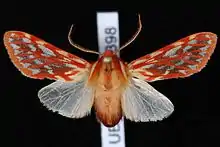Lophocampa roseata
Lophocampa roseata, the rosy aemilia, is a moth of the subfamily Arctiinae. It was described by Francis Walker in 1866. It is found in North America in western Oregon, Washington and southwestern British Columbia. The habitat consists of conifer forests and urban landscapes.[2]
| Lophocampa roseata | |
|---|---|
 | |
| Scientific classification | |
| Kingdom: | |
| Phylum: | |
| Class: | |
| Order: | |
| Family: | |
| Subfamily: | |
| Genus: | |
| Species: | L. roseata |
| Binomial name | |
| Lophocampa roseata | |
| Synonyms | |
| |
The length of the forewings is 14–15 mm. The ground color of the forewings is light yellow with brown transverse lines and bright orange-red veins, with hindwings a translucent light yellow. Adults are on wing in mid-summer.
The larvae have been successfully reared on Douglas-fir,[3] with the first several instars closely resembling the red cone scales of their coniferous host plants.[4]
The final instar is covered with long setae, and are mottled with yellow, white and black hair tufts.
Subspecies
- Lophocampa roseata roseata
- Lophocampa roseata occidentalis French, 1890 (Rocky Mountains, Colorado)
References
- Savela, Markku. "Lophocampa roseata (Walker, 1866)". Lepidoptera and Some Other Life Forms. Retrieved February 6, 2018.
- Pacific Northwest Moths
- "PNW Moths | Lophocampa roseata". pnwmoths.biol.wwu.edu. Retrieved 2021-10-13.
- Caldwell, Christie (2023). "Life history of Lophocampa roseata (Walker, 1866)". News of the Lepidopterists Society'. 65 (1): 3–6 – via Yale.
- Pitkin, Brian & Jenkins, Paul. "Search results Family: Arctiidae". Butterflies and Moths of the World. Natural History Museum, London.
